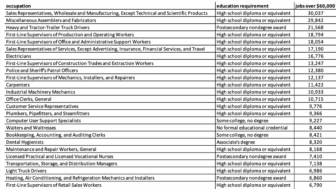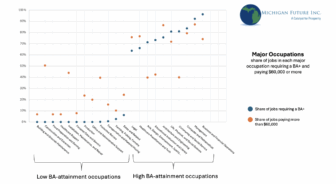![]() Following a weekend in which, for the second year in a row, women around the world marched for a variety of issues affecting women and communities they care about, I thought it would be appropriate to spend a minute here asking: how are women in Michigan doing these days?
Following a weekend in which, for the second year in a row, women around the world marched for a variety of issues affecting women and communities they care about, I thought it would be appropriate to spend a minute here asking: how are women in Michigan doing these days?
For my answers, I turned first to one of our favorite data sources: the Michigan Association of United Ways’ ALICE report. The reason this report has become such a reliable source of interest for us is that it provides an important look at people and families who are not living in poverty—but who are nevertheless struggling to afford basic necessities. ALICE stands for Asset Limited, Income Constrained, Employed. In other words, the report provides a rich, data-filled description of the families who are both working and on financially precarious footing. The most recent ALICE report was released in April 2017. While ALICE doesn’t break down most of its analysis by gender, I was able to use it as a context and a lens for looking at 2016 census data. I also consulted a 2013 report on the State of Women from the Center for American Progress for ideas about other data points to look up (to be clear, I looked for updated figures using U.S. Census and Bureau of Labor statistics data).
The general contours of the ALICE report are startling. 40 percent of Michigan households are either below the federal poverty line, or fit the ALICE definition. Which makes sense when you consider that 60 percent of Michigan’s jobs pay less than $20 per hour, and around 40 percent of jobs pay less than $15 per hour. Meanwhile, costs of living have risen significantly since 2007. And while there are differences across the state, a significant portion of the population in every county is living below the ALICE threshold. The number is below 30 percent in only three counties, and many counties have near 50 percent. In other words, there are people struggling around the state, not just in certain communities.
The ALICE report does look at the discrepancies between households with children that are led by a married couple, vs. single-family households led by women or men. Married households with children, which are more likely to have two incomes, are doing far better than non-married. The worst-off are the single-family households headed by women. Only 20 percent of those households are living above the ALICE threshold of meeting basic needs, and over half of those households are below the poverty line. There are also many more of them than there are single-family households headed by men—260,000 to 88,000. Doing the math, Michigan has 130,000 households with children that are headed by a single woman that are not able to meet their basic necessities.
In the ALICE household survival budget, childcare for two children accounts for 24 percent of the budget, provided that parents choose the least expensive daycare option. The expense of childcare is a huge strain on the possibility for Michigan’s women to achieve any savings or financial stability.
Education and Employment
One area where Michigan women are doing well compared to men is in education. They are roughly on par with men, and in some areas outperform them, in educational attainment. According to American Community Survey’s 5-year estimates for 2016, 16.6 percent of men have a bachelor’s degree; 16.8 percent of women do. A greater proportion of women than men have associate’s degrees (10.3 percent vs. 7.9 percent). Unfortunately, Michigan’s college attainment lags the nation, so the fact that we are somewhat equal essentially means we are equally low-performing.
And of course, in the areas of educational attainment, we see stark racial disparities persisting. While white women are on par with white men, with the exception of Asian Americans, every other racial subgroup is earning college degrees at lower rates. While over 28 percent of white women have bachelor’s degree or higher, only 19.3 percent of black women do (and the percentage is lower for Hispanic, American Indian, and other ethnicities). Interestingly, while white women are achieving degrees at about the same rate as white men, there is less parity in other racial groups—often with women achieving at higher rates than men.
Yes despite women’s educational achievements, Michigan has a staggering wage gap. On Friday, I’ll pick this topic back up with a table that compares income by educational attainment for men and women.







